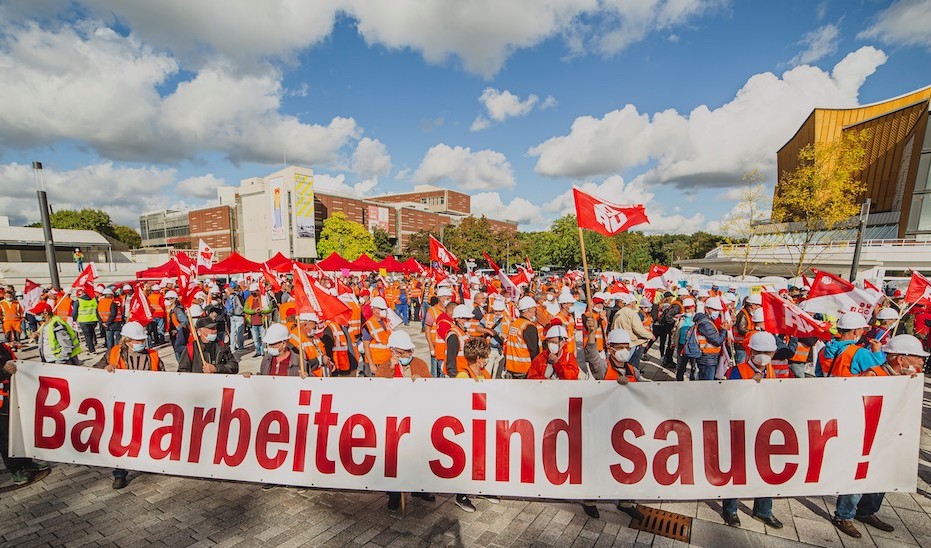After intense mediation and saber-rattling, Germany’s big construction union IG BAU and management reached a deal Oct. 15 after midnight that—pending final approval by some 890,000 members and employers—averting a potent strike threat, its first in almost 20 years, and pushing efforts to balance wage disparities between the country’s east and west regions.
IG Bau leader Robert Feiger invoked “the sword of Damocles” after the first round of mediation failed to reach agreement, with industry organizations countering that the union was misrepresenting management proposals.
“Our ideas for fairer pay for employees were definitely higher, but we can live with this compromise,” Feiger said after the deal.
Uwe Nostitz, chief negotiator representing the two employer trade groups, described the talks as lengthy, difficult and complex, tackling new issues not in previous contracts. Jutta Beeke, a vice-president at HDB, the German industry association representing large-sized construction companies, was glad for the stability brought by the deal. “We’ve succeeded in negotiating a comprehensive package, and have a result that in the long term can provide planning security for companies,” he said.
The deal addresses pay scales in eastern Germany and in its more affluent western region, which still diverge more than 30 years after the country’s unification following the fall of the Berlin Wall. It means employees in eastern Germany receive a 3% wage increase as of November and a one-time lump sum for pandemic-related support; they can expect a further 2.8% salary hike as of next April 2022 and 2.7% in April 2023.
Employees in the west would receive 2% on Nov. 1; 2.2% in April and another 2% in April 2023, along with the COVID-related lump sum payout. It will mean, for instance, that a mid-career construction worker in eastern Germany will see a wage boost soon from 19.94 euros, about $23.14 per hour, to 20.54 euros, about $23.83.
The main sticking point, however, was in forging agreement on per-kilometer travel scale costs for workers that are sometimes bussed 30 or 40 miles to a job site.
IG Bau represents construction trade workers, including roofers, general construction, painters and scaffolders, as part of an industry sector consisting of hundreds of thousands of enterprises—from small operations of 10 and less to huge contractors such as Bilfinger, Hochtief and Bauer—that altogether employ 2.5 million and report revenue of $400 billion annually.
Management is represented by the large trade association ZDB, which covers smaller enterprises, and HDB, which covers the larger concerns. However, Hochtief, one of Germany's largest engineering and construction firms and a global industrial power, in 2016 decided to step away from the HDB umbrella and negotiated its own in-house deal with IG BAU.
The contract talks come at a time when labor relations are somewhat fraught as the German economy tries to keep its footing through the body blows coming from the financial and EU currency crisis of a decade ago, an increasingly mobile workforce, waves of inward migration from war refugees and would-be immigrants in 2015 and 2106 and the ongoing pandemic.
Germany has seen several strikes this year from rail workers, and retail supermarket and department store employees are in tough ongoing contract negotiations, warning that strikes are a possibility.
“What we have seen in recent years is pressure, and a bit of a downward spiral in many countries, when it comes to labor conditions and salary in construction especially due to the increase in the number of mobile workers,” says Tom Deleu, general secretary of the European Worker’s Industry Federation for building, woodworking and forestry trades in Brussels, Belgium.
That umbrella organization represents 76 affiliated unions in 35 countries to the European Union and European Commission, and Deleu describes long-running fissures as workers in the eastern EU countriea move west in pursuit of higher-paying jobs, and workers outside the EU migrate to Romania, Poland and the EU’s eastern flank.
“During Covid, these problems were very much visible, says Deleu. "There were problems with sanitary and public health conditions for these workers: many live in small spaces with too many workers, and are transported to worksites in small busses, and then border crossings became very difficult.”
Construction is expected to boom with near-term resources coming in to support reconstruction from this summer's epic flooding damage, big moves to sustainable energy and infrastructure, as well as renovation and new residential builds.
There is also a growing shortage of workers, Deleu says. “In general, it’s more difficult to find agreement than before: more rounds of negotiation needed, more unrest. That seems to be a trend.”
There has been labor peace, relatively speaking, for the last two decades in German construction. Workers went on strike in June 2002 for one week in an IG BAU-led action that eventually involved 30,000 workers at 1,000 construction sites before a deal was reached in a 22-hour bargaining session.


Post a comment to this article
Report Abusive Comment